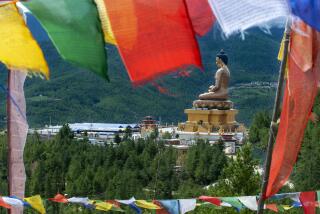Bhutan Sorts Out Its Cures : Medicine: The tiny kingdom seeks to blend ancient and modern practices. It’s busy analyzing hundreds of traditional medicinal plants.
- Share via
THIMPHU, Bhutan — The tiny Himalayan kingdom of Bhutan, creeping slowly into the modern age, is looking for a way to blend the use of its ancient traditional medicine with Western cures.
The government has embarked on a project to analyze and catalogue more than 600 medicinal plants growing in the rugged mountains and valleys tucked between China and India.
“Our objective is to develop traditional medicine and integrate it with modern Western medicine. The government recognizes the potential of traditional medicine,” says Dr. Paolo Morisco, an Italian coordinating the Bhutanese project.
The local people call their country the “Land of the Thunder Dragon.” Legend says Bhutan’s medicinal plants, used by traditional doctors for more than a thousand years, first sprouted in spots where a “liquid of immortality” spilled down from the heavens.
Morisco and his colleagues at the National Research and Training Institute of Traditional Medicine in the country’s capital, Thimphu, have set out to analyze the plants, as well as minerals, stones and animal products that go into the cures.
Local doctors, who store the ingredients in large metal containers, crush and mix as many as 30 different substances for one prescription, then dispense it wrapped in paper.
The plants are collected by farmers and yak herders as high as 18,000 feet in the Himalayas.
Bhutanese medicine, similar to that of neighboring Tibet, is a combination of Chinese, Indian and other regional practices.
Developed more than a millennium ago, much of it has been documented in manuscripts still printed with woodblocks and tied in neat bundles with cloth.
Dungtshos, or traditional doctors, examine patients at the hospital in small, dark rooms dominated by large spinning Buddhist prayer wheels in the center.
One dungtsho recently diagnosed a young female patient by grasping her forearms and apparently feeling her pulse with three fingers of each hand. Then he sent her off to the dispensary with a prescription.
“It’s more like a nerve reading than a pulse reading,” Morisco said. “It makes our pulse reading look like child’s play in comparison.”
Little research has been done on the effectiveness of the diagnosis and treatment, but up to 250 patients come each day, seeking the traditional cures their ancestors used.
“We’re trying to develop a protocol of referrals between this and the other (Western) hospital,” Morisco said.
“Traditional medicine is good at treating diseases such as arthritis and common illnesses such as asthma. Western medicine is better at acute bacterial infections and sophisticated surgery.”
Faith also plays a strong role in medicine in the deeply Buddhist nation of 1.3 million people, most of whom are subsistence farmers.
More to Read
Sign up for Essential California
The most important California stories and recommendations in your inbox every morning.
You may occasionally receive promotional content from the Los Angeles Times.










